CAA News Today
Member Spotlight: Meet New Editor-in-Chief of Art Journal, Derek Conrad Murray!
posted by CAA — August 01, 2024
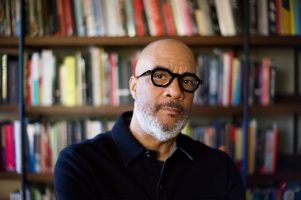
Can you tell our members about your current academic post, research interests, and larger scholarly motivations?
I am currently Professor of History of Art and Visual Culture at the University of California, Santa Cruz. My research is in late modern and contemporary art and visual culture. I’m an interdisciplinary theorist who utilizes methodologies and critical approaches from various disciplines and fields. Much of my research focuses on the conjunction between ideology and visuality, and I often explore the interrelations between identities and cultural identifications and contemplate the complexities of their envisioning.
In recent years, I’ve been exploring the broader multidisciplinary landscape of visually based research. The increasing expansiveness of arts-related and visual culture scholarship across disciplines and fields has inspired me to consider the necessity of multidisciplinary collaboration. As society has become inundated with images—many of which are intended to spread propaganda, disinformation, insidious forms of social engineering, and nefarious capitalist agendas—there’s an ever-growing multidisciplinary urgency to critically contend with the visual. In response to this complex visual landscape, there is a need for arts writing to embrace a broader range of methodological and critical frameworks. My approach has always been to maintain an openness to embracing emerging ideas that hold the potential to transform how we envision the social role of artistic production, art history, theory and criticism, and visual culture.
I’m also motivated by the failures of empathy and decency that plague our world, not to mention within many of the institutions we operate in. My work thus far is a reflection of my ethical commitment to inclusivity and an expansive interest in culture. I have always had a strong impulse not to look away and a resistance to disidentifying with the humanity and social struggles of others. I have committed myself to always fostering empathy and mutuality to the extent that I can—while maintaining a parallel dedication to disciplinary and methodological expansiveness. My commitment to inclusivity and multidisciplinary is a priority and has encouraged me to bring together diverse artists, scholars, and cultural producers from various backgrounds into critical conversation.
What is your vision for Art Journal during your term as Editor-in-Chief?
My vision is rooted in a commitment to supporting pathbreaking creative and intellectual work—and modeling an editorial approach invested in the transnational exchange of ideas. I am inspired by new critical approaches that may break from scholarly trends, ideological fixities, and expected modes of thought. To achieve this aim, I acknowledge that resisting the abusive forms of social control, division, and marginalization that plague our world necessitates embracing often unexpected perspectives. Doing so, I believe, will significantly expand the journal’s reader base. However, technology has also presented challenges to the traditional means by which intellectual ideas are circulated and valued in our discipline and its related fields. The rise of Internet-based, public-facing art discourses occurring in online journals has created new readerships and a broader expansion of emergent ideas. I truly believe that Art Journal can be at the forefront of expanding how we envision the social role of the arts.
I also look forward to locating and supporting impactful artmaking that may be adrift from representational and conceptual trends and the often overbearing dictates of market forces. Building strong relationships with artists is a personal priority, but I endeavor to acknowledge how new technologies have led to an ever-expanding understanding (or reimagining) of what an art object is formally and aesthetically. And I have always been critical of the binary-based dividing lines so often drawn between aesthetic formalism and the concerns of identity and representation. I am committed to breaking free of these non-productive delineations—while maintaining a commitment to openness and mutuality that necessitates listening to, respecting, and supporting a broad range of cultural producers.
What motivated you to become E-I-C of AJ? How does your research and public scholarship dovetail with your vision for the journal?
Art Journal has been a fixture in my life from my undergraduate and graduate school years to my professional career. I’ve always been an avid reader of the journal. It had a huge impact on me intellectually as an undergraduate art student, and during those years, I started to become more interested in the histories and critical ideas around art than its making. However, at the time, I had no idea what to do with that interest. In 2004, a year before I completed my doctoral degree at Cornell, I published my first feature-length article in Art Journal: “Hip-Hop vs. High Art: Notes on Race as Spectacle.” That publication was pivotal to my burgeoning career as a scholar. At the time, I had simultaneously begun publishing in NKA: Journal of Contemporary African Art, which, during those years, was published at Cornell by editors Salah Hassan (my advisor) and the curator and critic Okwui Enwezor. Because of their commitments to greater inclusivity and internationalism in art scholarship, NKA, and Art Journal were personally the most impactful art publications during my formative years. Both gave me recognition and a strong sense of professional possibility. In the following years, I published in Art Journal on several more occasions, eventually leading to serving on the AJ Editorial Board from 2016 to 2020.
Throughout my career, Art Journal has been a leading forum for progressive arts scholarship, and it has profoundly informed how I approach my own work. The journal has been particularly impactful for underrecognized scholars, artists, and arts professionals, so I am extremely grateful for the opportunity to continue and expand upon the exemplary editorial work of my predecessors. The values and commitments that drive my scholarship have always been intertwined with Art Journal. Few art publications are as open as AJ, so it’s a natural home for me intellectually and situates me within a milieu where I can engage in productive and enriching conversations with a diverse group of cultural producers. I endeavor to break from the conventional thinking of my discipline, so I seek out artists and intellectuals with similar commitments, especially those who are compelled to make a measurable difference in the lives of others and, by extension, are committed to the well-being of society. In keeping with Cornell’s founding principle, “. . . any person . . . any study,” I am a strong advocate for nurturing and protecting the unfettered intellectual possibilities of scholars within my discipline and its related fields. Regardless of their identities, scholars should feel their intellectual and scholarly endeavors are supported and cultivated. And who they are perceived to be should not hinder the perception of their expertise. At root, my vision is about fostering inclusivity, new ideas, and intellectual freedom.
And finally, what are you reading/viewing these days? What is inspiring you?
Lately, I’ve been listening to Helga Davis’s podcast, HELGA, which has some terrific—and often very personal and reflective—interviews with artists and other impactful creatives and thought leaders. I’m currently fascinated by several films: Showing Up (dir. Kelly Reichardt, 2022) and Civil War (dir. Alex Garland, 2024). While completely divergent narratively and visually, both films engage with the often-fraught condition of being a producer of images and aesthetic objects. Showing Up envisions the contemplative quietude of creative practice, art school, and the subtle forms of competition, insecurity, and isolation of being a gallery artist—while Civil War is a disturbing exploration of the ethical quandaries and psychic traumas of being a war photographer. I’ve been thinking about these films because they wrestle with the role of art and artists in a time where the visual matters more than ever. I recently re-watched Louis Malle’s My Dinner with Andre (1981), and I started thinking about how much—because of the COVID-19 pandemic—I missed having lengthy in-person conversations with others. I think we’re all coming out of that isolation and attempting to relearn how to interact again. And that interaction is necessary for empathy, reciprocity, and human connection.
Writer and director Cord Jefferson’s 2023 film American Fiction has also dominated my thinking lately. Among many intersecting themes, the film satirizes how perilous Black representation can be—and the particular quandary of the Black cultural producer negotiating a desire for individual expression in the face of a culture industry that often demands ethnic caricatures, trauma narratives, and Black stereotypes.
In terms of books, I’ve been reading Jack Whitten: Notes from the Woodshed (2018), edited by Kate Siegel; Craig Owens’s Beyond Recognition: Representation, Power, and Culture (1992); Percival Everett’s novel Erasure (2001); To Make Their Own Way in the World: The Enduring Legacy of the Zealy Daguerreotypes (eds. Ilisa Barbash, Molly Rogers, and Deborah Willis; Sara Ahmed’s On Being Included: Racism and Diversity in Institutional Life (2012); Göran Therborn’s The Ideology of Power and the Power of Ideology (1980), Zahi Zalloua’s Žižek on Race: Toward an Anti-Racist Future (2020); and Norman Mailer’s selected essays Mind of an Outlaw (2014).
Art Journal / AJO Editorial Board seeks new members!
posted by CAA — March 15, 2024
CAA invites nominations and self-nominations to fill two seats on the Art Journal / AJO Editorial Board for a four-year term: July 1, 2024–June 30, 2028. Candidates may be artists, art historians, art critics, art educators, curators, or other art professionals; institutional affiliation is not required. Art Journal, published quarterly by CAA, is devoted to twentieth- and twenty-first-century art and visual culture. AJO is an online forum for the visual arts that presents artists’ projects, conversations and interviews, scholarly essays, and other forms of original content. Committed to fostering new intellectual exchanges in the fields of modern and contemporary art, AJO prioritizes material that makes meaningful use of the web and publishes on a rolling basis.
The editorial board advises the Art Journal and AJO editors-in-chief and assists them in identifying authors, articles, artists’ projects, and other content for the journal; performs peer review and recommends peer reviewers; guides the journals’ editorial programs and may propose new initiatives for them; promotes and advocates for both journals; and may support fundraising efforts on their behalf. Members also assist the editors-in-chief to keep abreast of trends and issues in the field by attending and reporting on sessions at the CAA Annual Conference and other academic conferences, symposia, exhibitions, and events.
The Art Journal / AJO Editorial Board meets three times a year, with meetings in the spring and fall plus one at the CAA Annual Conference in February. The fall and spring meetings are currently held remotely. Members are expected to pay travel and lodging expenses to attend the conference in February. Members of all editorial boards volunteer their services to CAA without compensation.
Candidates must be current CAA members in good standing and should not be serving on the editorial board of a competitive journal or on another CAA editorial board or committee. Members may not publish their own work in the journals during the term of service. CAA encourages applications from colleagues who will contribute to the diversity of perspectives on the Art Journal / AJO Editorial Board and who will engage actively with conversations about the discipline’s engagements with differences of culture, religion, nationality, race, gender, sexuality, and access. Nominators should ascertain their nominee’s willingness to serve before submitting a name; self-nominations are also welcome. Please email a letter of interest and a CV as a single PDF to Eugenia Bell, Editorial Director.
Deadline: May 6
Art Journal Seeks Editor-in-Chief
posted by CAA — March 21, 2023
**THESE POSITIONS HAVE BEEN FILLED. NOMINATIONS ARE CLOSED**
The Art Journal/AJO Editorial Board invites nominations and self-nominations for the position of editor-in-chief for the term July 1, 2023–June 30, 2027 (with service on the Art Journal/AJO Editorial Board in 2023–24 as editor designate, and in 2027–28 as past editor). Art Journal, published quarterly by CAA, is devoted to twentieth- and twenty-first-century art and visual culture.
Working with the editorial board, the editor-in-chief (EIC) is responsible for the content and character of the journal. The EIC solicits content, reads all submitted manuscripts, sends submissions to peer reviewers, and provides guidance to authors concerning the form and content of submissions; develops projects; makes final decisions regarding content; and may support fundraising efforts on the journal’s behalf. A candidate may be an artist, art historian, art critic, art educator, curator, or other art professional. The EIC works closely with CAA’s New York staff, attends three meetings each year of the Art Journal/AJO Editorial Board—held in the spring and fall by teleconference or in New York, and in February at the CAA Annual Conference—and submits an annual report to CAA’s Board of Directors.
The position usually requires twenty hours a week. CAA provides financial compensation for course releases, usually to the EIC’s employer. The EIC is responsible for expenses related to travel and lodging.
Candidates must be current CAA members in good standing and should not be serving on the editorial board of a competitive journal or on another CAA editorial board or committee. CAA encourages applications from colleagues who will contribute to the diversity of perspectives on the Art Journal/AJO Editorial Board and who will engage actively with conversations about the discipline’s engagements with differences of culture, religion, nationality, race, gender, sexuality, and access. Nominators should ascertain their nominee’s willingness to serve before submitting a name; self-nominations are also welcome. A CV, a letter of interest from the nominee, and at least one letter of recommendation must accompany each nomination. Please send nominations by email to Eugenia Bell, Editorial Director, ebell@collegeart.org, and include “Art Journal Editor-in-Chief Search” in the subject line.
Deadline: April 30, 2023
Craig Houser, author of Chapter 5: “The Changing Face of Scholarly Publishing: CAA’s Publication Program.”
posted by CAA — December 09, 2021
As part of CAA’s 10-year anniversary celebration of its publication The Eye, the Hand, the Mind: 100 Years of the College Art Association, chapter authors reflect on their contributions and how their impressions of the field have changed. Our second video in the series features Craig Houser, who wrote Chapter 5, “The Changing Face of Scholarly Publishing: CAA’s Publication Program.”
Craig Houser is the director of the MA in Art History and its concentration in Art Museum Studies at the City College of New York. His scholarship has addressed institutional politics related to studio art and art history, as well as issues in gender and sexuality in modern and contemporary art.
CAA 2021: A look back on the past year’s programming, publications, and opportunities
posted by CAA — November 30, 2021
CAA has produced this reel with a compilation of events, scholarship, programs, and initiatives CAA from the last year. See below for a full list of each item (in order of appearance in the video) with links to learn more.
Programming:
CAA’s first virtual Annual Conference
Mariam Ghani in conversation with Laura Anderson Barbata
In Conversation with Dr. Nancy Odegaard
Theresa Avila, Annual Conference Program Chair in conversation with Meme Omogbai
An Inaugural Evening with CAA Distinguished Awardees and Artists
CAA Then & Now: Reflections on the Centennial Book and the Next Century
Karen Leader, author of Chapter 12: Advocacy
Opportunities:
Publication, travel, and support grants
Publications and Publications Programming:
Artist Project, Elana Mann for Art Journal Open
Roundtable discussion for Art Journal Open, Holding Space…
Art Journal and The Art Bulletin
caa.reviews book and exhibition reviews
caa.reviews’s dissertation roster, 2020
Global Programs
CAA-Getty International Program
CAA-Getty 10-Year International Program online publication
Podcasts
CAA Conversations by CAA’s Education Committee
CAA’s 110th Annual Conference will take place in Chicago from February 17-19, followed by virtual live sessions to be held in Zoom from March 3-5. For more information and to register go to this link.
Announcing the Appointment of Two New Editors for CAA Publications
posted by CAA — July 23, 2021
We’re pleased to announce the appointment of two new editors for CAA publications: Christy Anderson, was selected to be Editor-in-Chief of The Art Bulletin. Balbir Singh will take the post as Reviews Editor of Art Journal. They begin their three-year terms July 1, 2022. Learn more about their work below.
EDITOR BIOGRAPHIES
Christy Anderson | Incoming Editor-in-Chief of The Art Bulletin
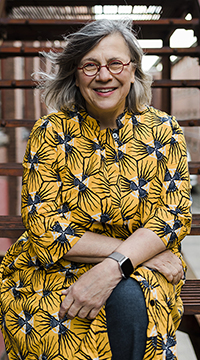 Christy Anderson is an architectural historian with a special interest in the buildings of Renaissance and Baroque Europe. Professor Anderson has taught at Yale University, the Courtauld Institute, MIT, and the University of Toronto. At Yale she received a Morse Faculty Fellowship as well as numerous teaching prizes. She received her Ph.D. from the School of Architecture at the Massachusetts Institute of Technology. As a Kress Fellow at the Courtauld Institute of Art and later as a Research Fellow at Worcester College, Oxford University, she studied the annotations made by the English architect Inigo Jones (1573–1652) in his collection of treatises and humanist literature. This work on literacy, architectural language, and the construction of the professional architect appeared in her book Inigo Jones and the Classical Tradition (Cambridge, 2006).
Christy Anderson is an architectural historian with a special interest in the buildings of Renaissance and Baroque Europe. Professor Anderson has taught at Yale University, the Courtauld Institute, MIT, and the University of Toronto. At Yale she received a Morse Faculty Fellowship as well as numerous teaching prizes. She received her Ph.D. from the School of Architecture at the Massachusetts Institute of Technology. As a Kress Fellow at the Courtauld Institute of Art and later as a Research Fellow at Worcester College, Oxford University, she studied the annotations made by the English architect Inigo Jones (1573–1652) in his collection of treatises and humanist literature. This work on literacy, architectural language, and the construction of the professional architect appeared in her book Inigo Jones and the Classical Tradition (Cambridge, 2006).
Learn more about The Art Bulletin.
Balbir Singh | Incoming Reviews Editor of Art Journal
 Balbir Singh’s scholarship focuses on the convergence of racial, gendered, and religious embodiment, with migration and policing under violent conditions of imperial and domestic security technologies. She is at work on her first book, “Militant Bodies: Violence and Visual Culture under Islamophobia,” which is rooted in questions that center post-9/11 racial and religious hyper-policing of Muslims and Sikhs, especially as they relate to bodily comportment and the donning of religious garments. Additionally, she is beginning research on a second book project — “Whose Terror? Vexed Attachments and the Contradictions of Freedom.”
Balbir Singh’s scholarship focuses on the convergence of racial, gendered, and religious embodiment, with migration and policing under violent conditions of imperial and domestic security technologies. She is at work on her first book, “Militant Bodies: Violence and Visual Culture under Islamophobia,” which is rooted in questions that center post-9/11 racial and religious hyper-policing of Muslims and Sikhs, especially as they relate to bodily comportment and the donning of religious garments. Additionally, she is beginning research on a second book project — “Whose Terror? Vexed Attachments and the Contradictions of Freedom.”
Apply to Serve on CAA’s Editorial Boards!
posted by Allison Walters — February 19, 2021
This time of year, members have the opportunity to provide an important contribution to CAA’s four journals—either by serving as a volunteer member of an editorial board or by applying to be an editor-in-chief or reviews editor.
Below are 14 opportunities to help shape the editorial vision of CAA’s publications.
Any member may self-nominate for the following positions or (after ascertaining interest) nominate another member. For more information, please click on the links below. You may apply for more than one position. The deadline for all applications is April 15, 2021. Terms of service vary, but they all begin July 1, 2021.
The Art Bulletin: 2 Editorial Board members
The Art Bulletin: Editor(s)-in-Chief
Art Journal/AJO: 1 Editorial Board member
Art Journal: Reviews Editor
caa.reviews: 2 Editorial Board members
caa.reviews Council of Field Editors: 7 openings
Early Modern European Art (North)
Latin American Art
Medieval Art
Precolumbian Art
Exhibitions New York
Exhibitions Northwest US
Exhibitions Southeast US
Art Journal Winter 2020 Video Abstract, “Now’s the Time,” a Message from Jordana Moore Saggese
posted by Allison Walters — January 13, 2021
Video Abstract – Now’s the Time from Taylor & Francis on Vimeo.
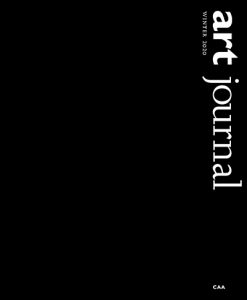
Art Journal Winter 2020
Usually when I sit down to write the introduction to a forthcoming issue of Art Journal, I am pleasantly surprised to find intrinsicconnections between the work we do as artists, historians, and critics. In past issues we have learned to look differently, to take matters personally, and to think in the present tense. And somehow we have done all this against an evolving (and often terrifying) backdrop of political, economic, social, environmental, and health crises. As I write this essay in early October, the pressure of reality—including the upcoming US presidential election—has made it difficult for many of us to orient ourselves to our research and creative practices. But, at the same time, the urgency of this work has never seemed more real.
In 2015 Toni Morrison wrote an essay for The Nation that, in part, framed her own feelings of helplessness in times of political and social turmoil. These days I find myself turning to these words again and again:
This is precisely the time when artists go to work. There is no time for despair, no place for self-pity, no need for silence, no room for fear. We speak, we write, we do language. That is how civilizations heal.
I know the world is bruised and bleeding, and though it is important not to ignore its pain, it is also critical to refuse to succumb to its malevolence. Like failure, chaos contains information that can lead to knowledge—even wisdom. Like art.
And so we must keep writing, making, and teaching. We must try to cultivate wisdom instead of succumbing to despair.
With Morrison’s mandate in mind I introduce this special edition of Art Journal: an issue centered on Blackness. The ideas represented here have been carefully brought into an intentional conversation around the experiences, expressions, and theorizations of Blackness. We have artist projects by two Black women—Allison Janae Hamilton and Chanell Stone—and all the book and exhibition reviews center on works by and about Black artists (thanks to the tireless effort of our reviews editor, Mechtild Widrich). The feature essays reorient our attention to artists—Mark Bradford, Samuel Levi Jones, Glenn Ligon, Howardena Pindell, Jack Whitten—who explore the histories, sensations, and consequences of Blackness in their work.
As argued so compellingly by Leigh Raiford in her essay, “Our work is to recognize how white supremacy functions as a way of seeing that any person of any race or positionally can work to undo.” I hope that in editing the first issue of Art Journal to focus exclusively on Blackness, I have provided a counterweight to the ideology of white supremacy that has infected our political landscape in the United States and (in so many ways) the history of art itself. As we mourn the murders of Ahmaud Arbery, Breonna Taylor, and George Floyd and the deaths of thousands from COVID-19, let us also work toward the new future and find meaning in the chaos.
– Jordana Moore Saggese
The entire issue of Art Journal Winter 2020 is free to read through March 31, 2021.
Announcing the Appointment of Three New Editors for CAA Publications
posted by CAA — October 01, 2020
We’re pleased to announce the appointment of three new editors for CAA publications: editor designate Eddie Chambers, who will take up his post as Editor-in-Chief of Art Journal, July 2021 – June 2024; Julie Nelson Davis, current Editor-in-Chief of caa.reviews, July 2020 – June 2023; and editor designate Stephanie Porras, who will take up her post as Reviews Editor of The Art Bulletin, July 2021 – June 2024. Learn more about their work below.
EDITOR BIOGRAPHIES
Eddie Chambers | Incoming Editor-in-Chief of Art Journal, July 2021 – June 2024
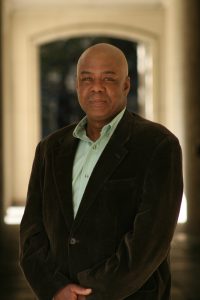 Eddie Chambers was born in Wolverhampton, England. He gained his PhD from Goldsmiths College, University of London in 1998, for his study of press and other responses to the work of a new generation of Black artists in Britain, active during the 1980s. He joined the Department of Art and Art History at the University of Texas at Austin in January 2010 where he is now a Professor. His books include Things Done Change: The Cultural Politics of Recent Black Artists in Britain (Rodopi Editions, Amsterdam and New York, 2012), Black Artists in British Art: A History Since the 1950s, (I. B. Tauris, London and New York, 2014, reissued 2015), and Roots & Culture: Cultural Politics in the Making of Black Britain, published 2017 (I. B. Tauris/Bloomsbury). He is the editor of the recently-published Routledge Companion to African American Art History. His forthcoming book is World is Africa: Writings on Diaspora Art (Bloomsbury, 2021).
Eddie Chambers was born in Wolverhampton, England. He gained his PhD from Goldsmiths College, University of London in 1998, for his study of press and other responses to the work of a new generation of Black artists in Britain, active during the 1980s. He joined the Department of Art and Art History at the University of Texas at Austin in January 2010 where he is now a Professor. His books include Things Done Change: The Cultural Politics of Recent Black Artists in Britain (Rodopi Editions, Amsterdam and New York, 2012), Black Artists in British Art: A History Since the 1950s, (I. B. Tauris, London and New York, 2014, reissued 2015), and Roots & Culture: Cultural Politics in the Making of Black Britain, published 2017 (I. B. Tauris/Bloomsbury). He is the editor of the recently-published Routledge Companion to African American Art History. His forthcoming book is World is Africa: Writings on Diaspora Art (Bloomsbury, 2021).
Julie Nelson Davis | Current Editor-in-Chief of caa.reviews, July 2020 – June 2023
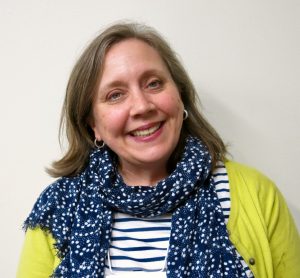
Julie Nelson Davis is Professor of the History of Modern Asian Art at the University of Pennsylvania. Recognized as one of the world’s foremost authorities on Japanese prints and illustrated books, Davis teaches a wide range of courses on East Asian art and material culture in the greater global context. After receiving her BA from Reed College, Davis completed her MA and PhD from the University of Washington and studied at Gakushūin University in Tokyo. She is author of Utamaro and the Spectacle of Beauty (Reaktion Books, 2007 and 2021), Partners in Print: Artistic Collaboration and the Ukiyo-e Market (University of Hawai’i Press, 2015), and Picturing the Floating World: Ukiyo-e in Context (in press). Davis was recently a guest curator for the Freer and Sackler Galleries for an exhibition on Utamaro (2017) and is preparing an exhibition of Japanese illustrated books at the University of Pennsylvania. She is currently working on a new project on issues of imitation, homage, and fakery in early modern Japanese art and their legacies into the present. In addition to her tenure as caa.reviews Editor-in-Chief from 2020 to 2023, Davis served as the field editor for Japanese art from 2001 to 2010 and a board member from 2007 to 2011.
Stephanie Porras | Incoming Reviews Editor of The Art Bulletin, July 2021 – June 2024
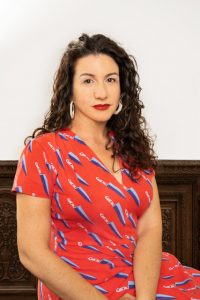 Stephanie Porras is Associate professor of Art History in the Newcomb Art Department at Tulane University, specializing in early modern art made in Northern Europe and across the Spanish world. Author of Pieter Bruegel’s Historical Imagination (Pennsylvania State University Press, 2016) and Northern Renaissance Art: Courts, Commerce, Devotion (Laurence King, 2018), Porras has also published widely on topics ranging from Albrecht Dürer’s drawings to Hispano-Philippine ivories. Her current book project, The First Viral Images considers the mobility of early modern artworks and their role in processes of globalization, and has been supported by fellowships at the New York Public Library, the Sterling and Francine Clark Art Institute, and the Center for Advanced Study in the Visual Arts at the National Gallery of Art.
Stephanie Porras is Associate professor of Art History in the Newcomb Art Department at Tulane University, specializing in early modern art made in Northern Europe and across the Spanish world. Author of Pieter Bruegel’s Historical Imagination (Pennsylvania State University Press, 2016) and Northern Renaissance Art: Courts, Commerce, Devotion (Laurence King, 2018), Porras has also published widely on topics ranging from Albrecht Dürer’s drawings to Hispano-Philippine ivories. Her current book project, The First Viral Images considers the mobility of early modern artworks and their role in processes of globalization, and has been supported by fellowships at the New York Public Library, the Sterling and Francine Clark Art Institute, and the Center for Advanced Study in the Visual Arts at the National Gallery of Art.
Deadlines extended! Serve on a CAA Committee or Editorial Board
posted by CAA — January 27, 2020
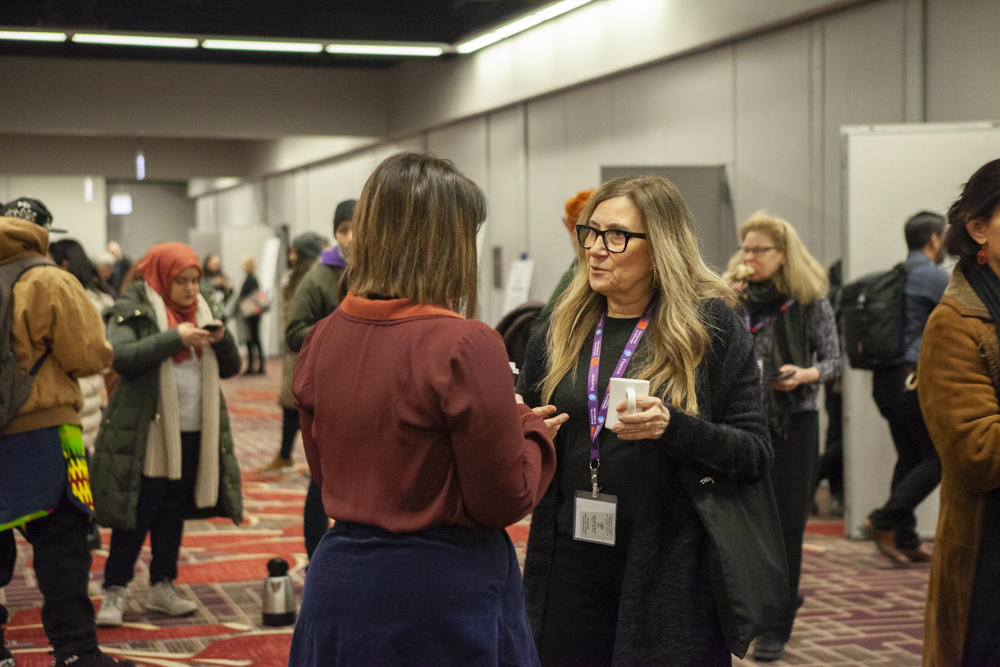
Attendees at the 2020 Annual Conference in Chicago. Photo: Stacey Rupolo
Each spring, members have the opportunity to provide crucial service to the field and gain an inside view by volunteering to work on a CAA committee or editorial board.
Any member may self-nominate for the following positions or (after ascertaining interest) nominate another member. For more information, please click on the links below.
CURRENT OPPORTUNITIES
Art Journal—Editor-In-Chief
Deadline (extended): June 1, 2020
caa.reviews—Field Editor for East Asian Art
Deadline (extended): June 1, 2020
Publications Committee—Two Members
Deadline (extended): June 1, 2020
PAST OPPORTUNITIES
Art Journal / Art Journal Open (AJO) Editorial Board—Three Members
Deadline: April 15, 2020
The Art Bulletin Editorial Board—One Member
Deadline: April 15, 2020
The Art Bulletin—One Reviews Editor or Coeditor Team
Deadline: April 15, 2020
caa.reviews Editorial Board—Three Members (One an Emerging Professional)
Deadline: April 15, 2020
caa.reviews—Eight Field Editors
African Art, African Diaspora/African American Art, Architecture and Urban Planning, Asian Art, Contemporary Art, Exhibitions: East Coast, Exhibitions: Midwest, Exhibitions: West Coast
Deadline: April 15, 2020


